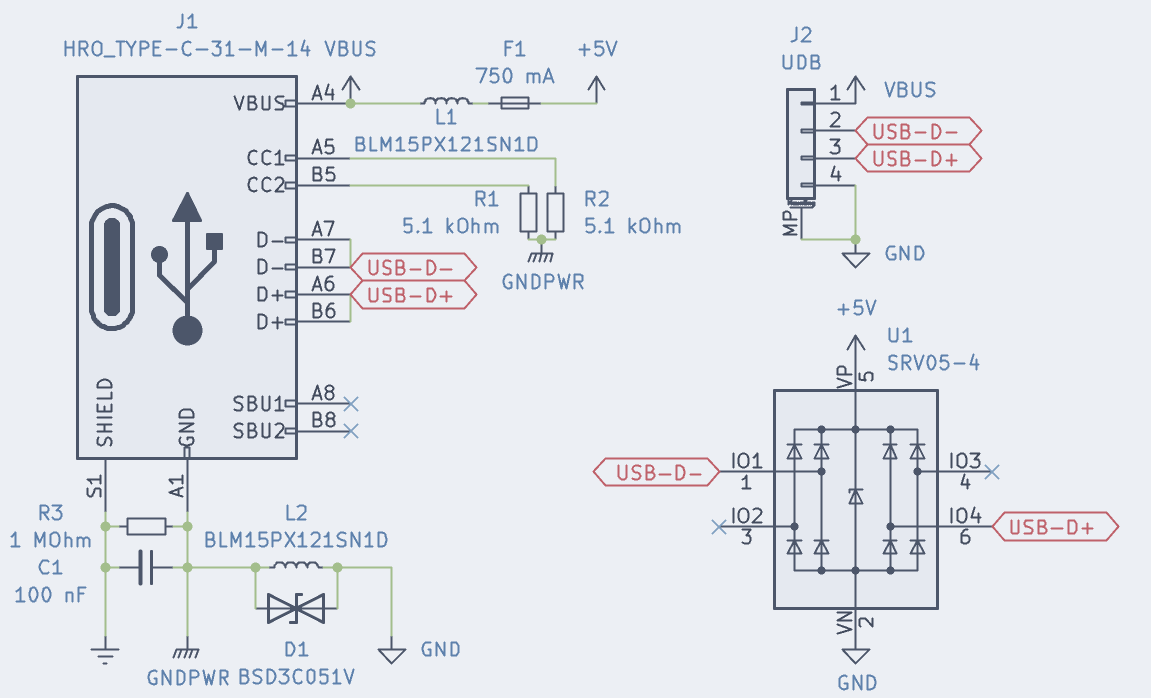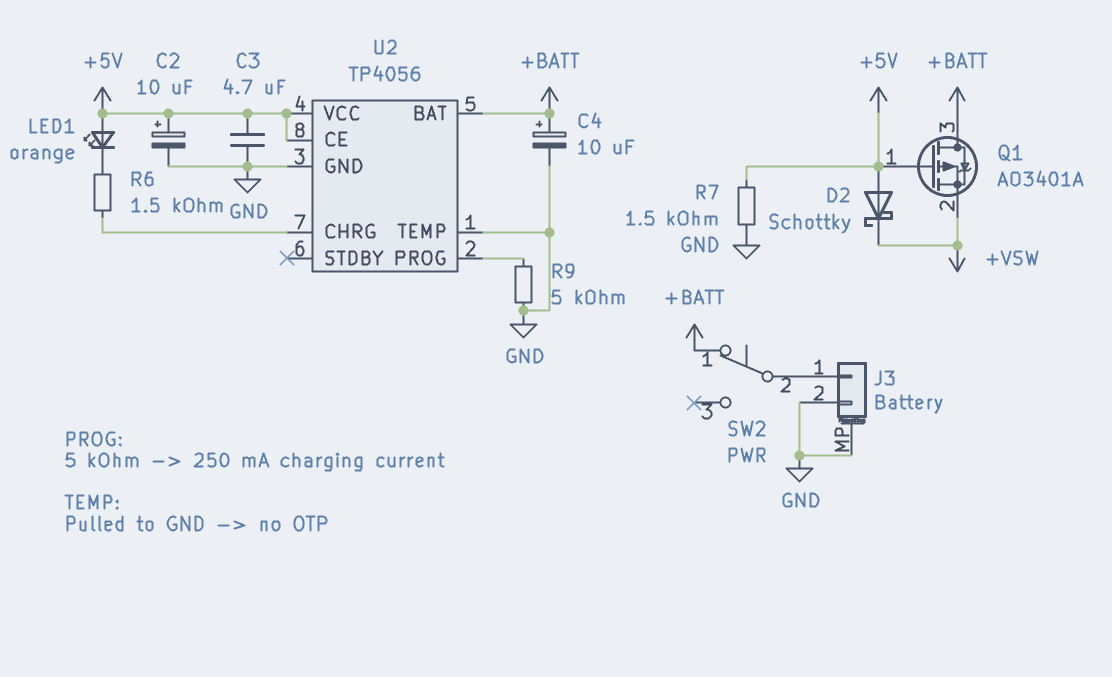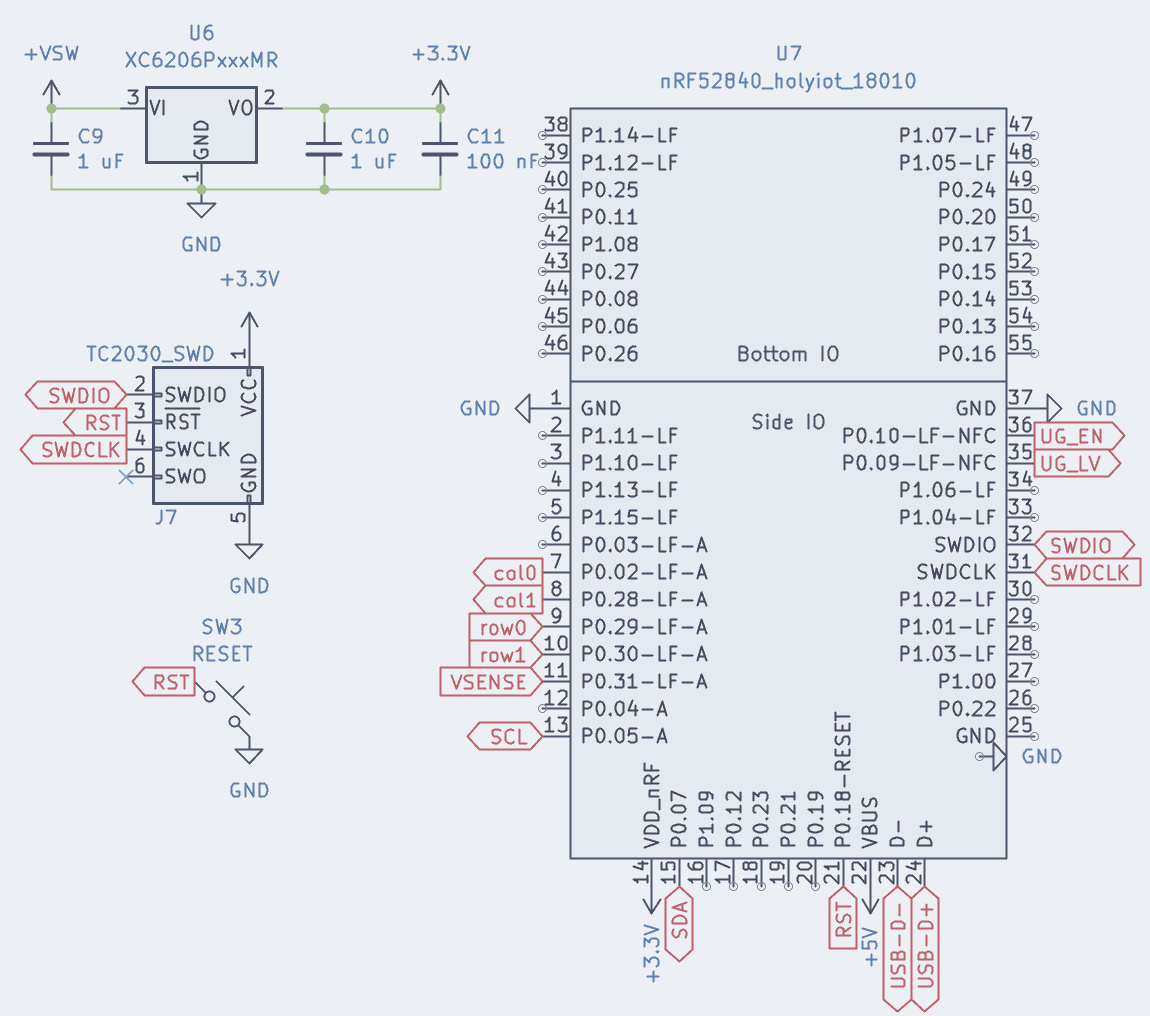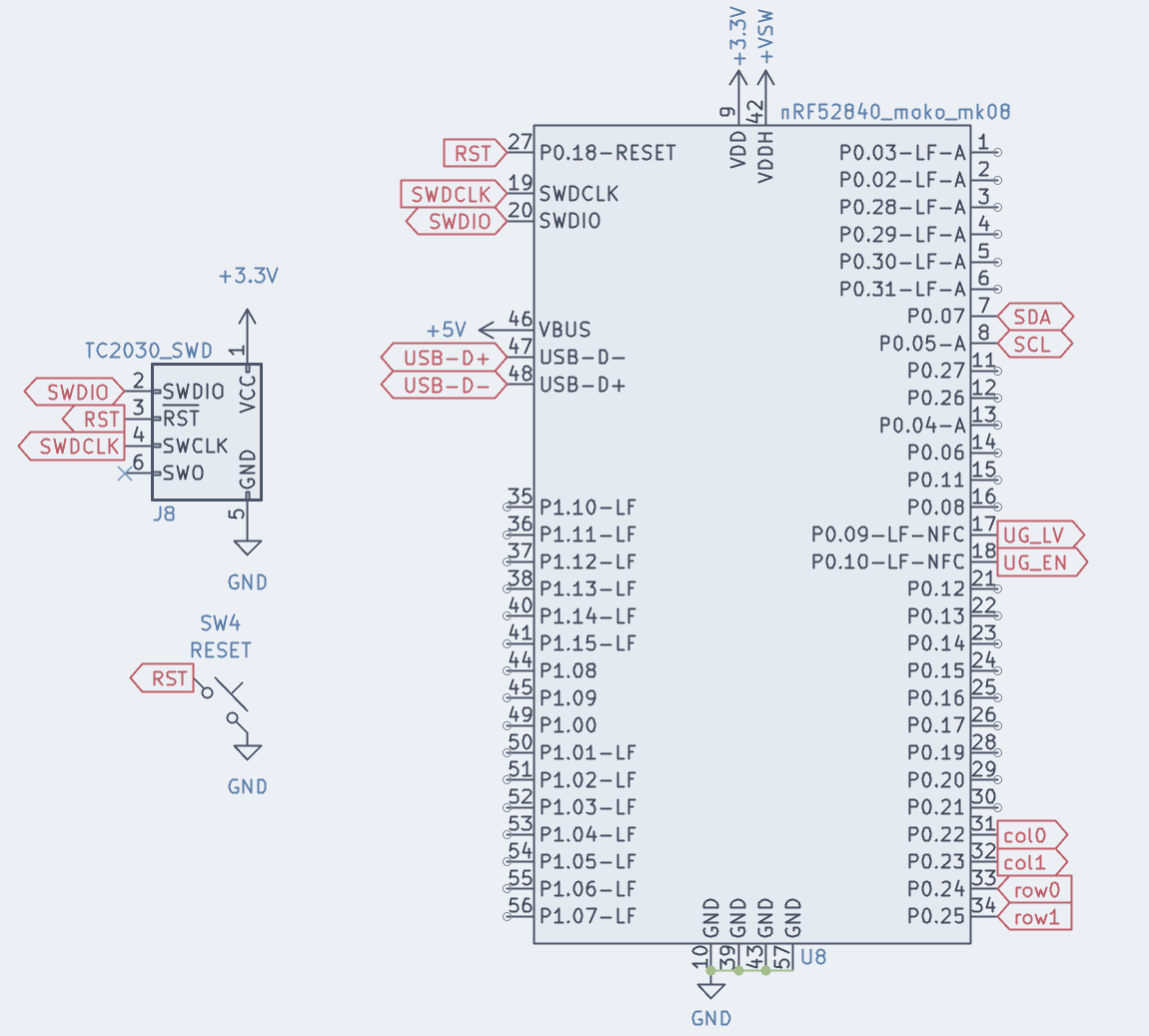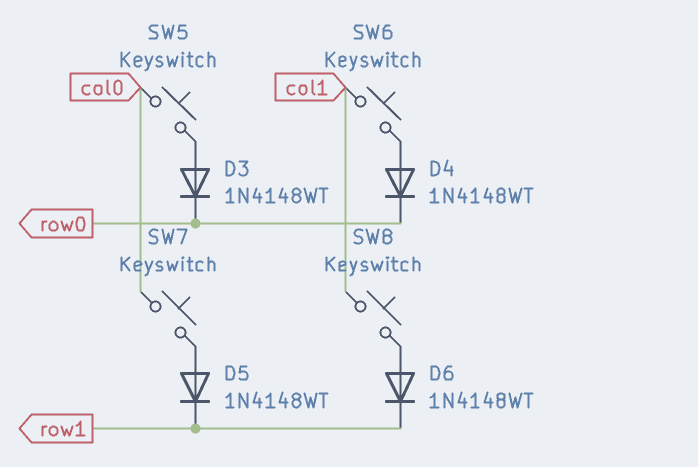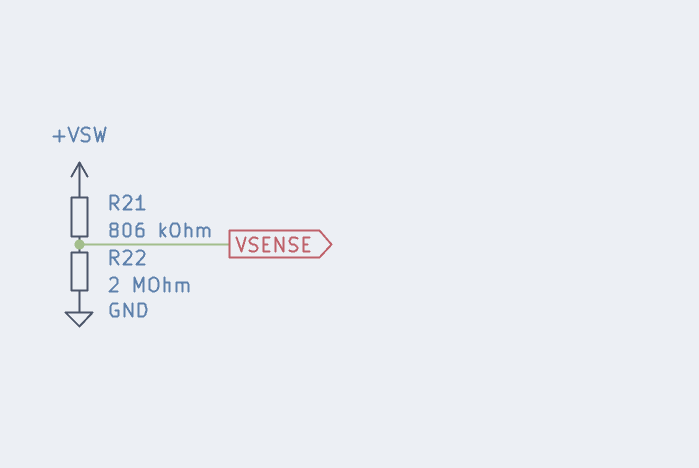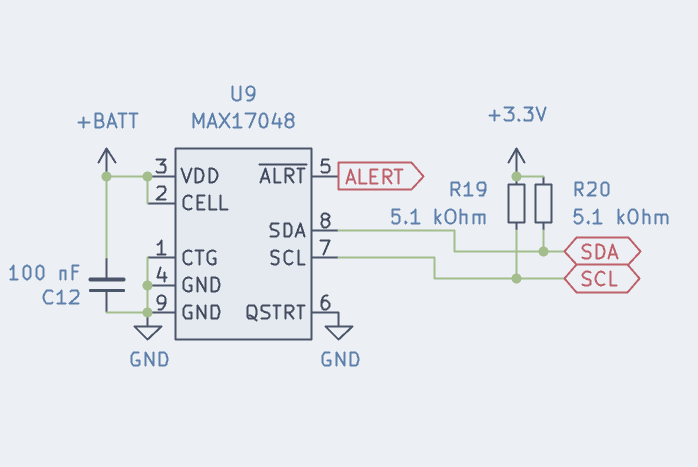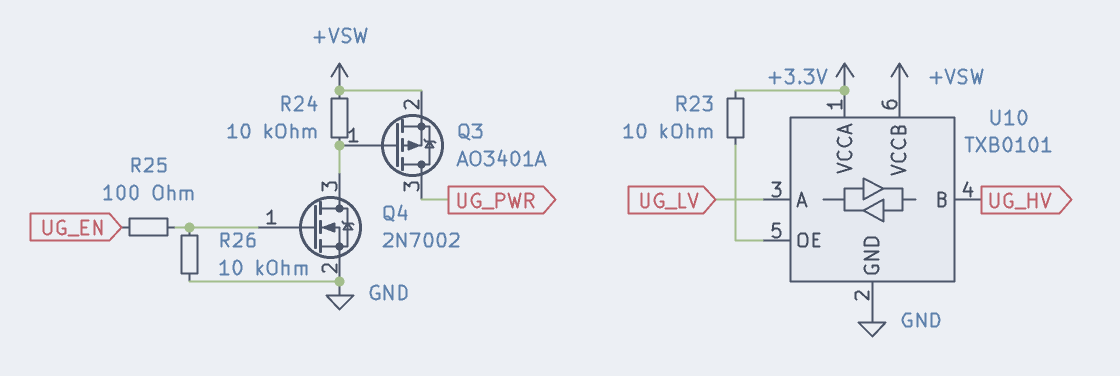Please note: This guide in its latest revision has just been published and may contain spelling mistakes as well as explanations referring to wrong components due to being written at an earlier stage, before re-annotation of the schematic. Please report any possible erorrs.
Since it's launch a few years ago, ZMK, an open source firmware for (mainly wireless) custom keyboards, has grown in both features and userbase rapidly and I have recently designed multiple boards making use of it in the past. Questions about how to design ZMK compatible hardware have been getting more common, and the first edition of my guide was a crude attempt at answering those. The third revision - which is only the second revision of the guide, but based on the third generation of wireless designs I made - is a more advanced and refined approach. It still contains all Rev 1 circuitry, but with small improvements, and multiple more "advanced" alternative schematic snippets, as well as better explanations and descriptions.
Most keyboard design guides focus heavily on QMK (and QMK compatible MCUs). While ZMK works flawlessly on STM32 (e.G STM32F303) and PCBs for those can be designed the same way as QMK compatible PCBs would be, the main appeal of ZMK is wireless operation, and I will focus on a nRF52840 based design in this guide. Keep in mind, this is no official ZMK team related guide - just a reference implementation from a user, for users. If you notice any errors, please report them either through github, or by contacting me some other way in order for me to fix them.
This is a rather advanced guide that expects some basic electronics knowledge, as well as design and routing experience. If you do not have those, i would recommend going over the ai03 PCB design guide first. It's a great explanation of most basics needed to design your first keyboard.
Many symbols (and/or their matching footprints) in this guide are taken from marbastlib, a keyboard-focused open source library of kicad footprints and symbols maintained by me and MarvFPV. While it is possible to use different libraries, I recommend sticking to it, since it's footprints/symbols are tested and confirmed working. While it used to be installed as a submodule to the project folder, we have now moved it to the KiCad pakcage manager system with KiCad 7. An installation guide can be found in the repo linked above.
- Introduction
- What do I need for a Bluetooth keyboard?
- This is too complicated for me!
- Schematics and design considerations
This section lists the important parts, as well as some basic considerations. Detailed explanations follow below. There is plenty of compatible parts that work well, some may even work better than the ones I chose. This is, however, focused around parts I am familiar with and have already prototyped to ensure proper operation. I will list multiple options, ranging from simpler to more complicated and advanced, usually also more expensive choices. Which is right for you depends on your budget, capabilities and requirements, so I opted for leaving you with multiple choices.
-
USB Port and protections: For flashing, possible wired operation and, most importantly, charging, you still need a USB port. I went with a USB-C port. The HRO M12 and M14 type connectors are cheap and easy to source, easily hand-solderable and routable and provide great mechanical stability. The protections I chose on this PCB are a good compromise between cost, PCB estate and protections - offering enough protection for a keyboard, while being easy to route. I added a JST 4-pin SH connector as an alternative, which can be used to connect an ai03 unified compatible USB daughterboard.
-
Battery management: There's lots of different controllers for this application. I will show you two possible choices, a cheaper and a more expensive (but also more feature-rich one). They both are available at jlcpcb for prototyping, easy to route, and offer programmable charge current - allowing to set it to the maximum USB 2.0 allows (500 mA). Power switches are optional, due to ZMKs astonishingly low idle power draw, but examples were included anyway.
-
Battery: Not much to say here. Pick any decent LiIon/LiPo single cell battery that fits your keyboard. More capacity = longer battery life. You can consult the ZMK Power Profiler to get a rough estimate of your expected battery life. Try not to poke it with sharp objects (switch pins on high-flex plate designs! Ideally add a protective FR4 or Alu plate between battery and switch pins) or reverse the polarity while connecting it to the PCB if you don't want to burn your house down. Batteries are awful.
-
MCU: All is based around a Bluetooth enabled, ZephyrOS capable MCU. In my case, I went with an nRF52840 due to good software support and hardware availability, as well as Bluetooth 5 Low Energy capability. I recommend using a dedicated module instead of the bare chip, due to those offering a wide range of certificates (proving your board won't alert the white vans with the big antennas on the roof), because nRF52840 are rather annoying to route, and it's impossible to reach all pins without 4 layers and microvias, which are serious price-driving options. In this tutorial I will go over two different modules, which each have their pros and cons. There is countless other choices, so I recommend you look for yourself which of the extensive list of certified modules best fits your needs.
-
Optional: Voltage sensing: ZMK supports battery charge reporting over Bluetooth - handy to know how much runtime you have left. Depending on the module you use, and the accuracy you want to achieve, multiple options will be discussed.
-
Optional: Underglow: ZMK supports WS2812/SK6812 adressable LEDs for underglow. An additional power cutting circuit that completely cuts the LEDs from the supply voltage while turned off is recommended, because those have rather high idle draw at ~1 mA per LED even when off and will chew through your battery in no time. Unless your design uses beefy batteries, I would recommend omitting LEDs in general - blinking lights are pretty, but months of battery life are even nicer in my opinion. With a power cutting circuit you give the user the option to choose.
Well, don't despair. There are easier ways of making wireless PCBs - there is multiple Arduino Pro Micro compatible devboards sporting an nRF52840 chip, for example the nice!nano, designed by a ZMK team member, nicell. These boards take care of (almost) everything mentioned in this guide for you, enabling you to make a wireless keyboard without bothering with all the crazy tech-talk.
If you are like me, however, and enjoy a challenge, and are up to learning something new - let me be your guide, and show you around the crazy world of wireless keyboards!
In the following chapters I will show (tested!) sample schematics for all relevant parts mentioned above, explaining the most important components, as well as my design considerations behind various components.
J1 is a basic USB Type C 2.0 connector, as used in most modern custom keyboards. I recommend using either HRO Type-C-31-M-12 (regular top-mount) or HRO Type-C-31-M-14 (mid-mount) as they are proven, reliable and easy to source.
R1 and R2 identify the board as a client for Type C hosts (like smartphones or notebooks connected with a C to C cable). The ferrite beads L1 and L2, together with the input caps of the board, forms a low-pass filter to eliminate incoming HF noise, induced over badly shielded cables or by GPU/CPU voltage regulators in the PC.
An electrostatic discharge applied to keyboard ground, however, must be able to pass to host GND (and therefore, Earth), but would be blocked by the low-pass as well. For this a suppressor diode is placed in parallel, which allows for high voltage discharges to flow freely.
R3 and C1 terminate Shield to Ground of the USB connector - having a low-impedance connection here would create a large ground loop over the whole cable (since on the host they are connected as well), while the capacitor still allows for RF to be shorted to shield. This is a common way of connecting the USB shield, and to be honest I only copied it from others without too much reasoning. It works. Unless you are ready to enter a rabbit hole, avoid googling how to properly handle USB shield. There seem to be as many opinions as there are electrical engineers on the net.
J2 is a 4pin JST SH connector with the correct pinout to be used with the ai03 unified daughterboard standard. It would for example be compatible with the various ai03 unified revisions. No ground filtering is present on this connector, since it is expected to be done on the daughterboard. If you plan on using an early/cheaper version without filtering, connect it before the input filters instead.
U1 is a cheap and widely used dataline-protector diode + TVS array. It can protect up to 4 data pins (only 2 are used in this case, you could use the remaining two for CC1/CC2 datalines) against voltages higher than VBUS or lower than GND, and the integrated TVS will dissipate any voltage higher than 5 V (or lower than GND) on VBUS. Together with the fuse (F1) this forms an effective crowbar-like protection circuit against over-voltage or reverse-voltage on the supply lines.
The TP4056 is a very wide-spread chip, available from a variety of brands and easy to implement. It is, however, not suited for powering a circuit while also charging a battery. It measures battery current to determine a fully charged battery, which will lead it to stop charging to avoid damaging the cell. For more information, check out this blog post. If the keyboard draws additional current, this threshold will be reached later (or not at all), leading to increased battery wear. That's what Q1 is used for - the Shottky diode D2 will power the MCU directly off 5V USB instead of the battery while plugged in, while during battery powered operation Q1 serves as an ideal diode (diode without significant forward voltage loss), supplying the MCU off the battery.
Disclaimer: I have NOT prototyped the parts around Q1 yet, and most likely never will. I included it referencing the post linked above. Please consider the information given there, and proceed with caution. For a board without LEDs you may as well omit them - the current draw of an nRF52840 alone will not suffice to keep the TP4056 in charging mode.
The temperature sensor input is disabled in this implementation, since most cells used in keyboards bring their own, built-in temperature protections with them. The value for R9 (PROG input) can be seen in the datasheet for the chip - 5 kOhm results in a charging current of 250 mA. Usually it should be between 0.5C and 1C (for a 500 mAh battery: 250 mA to 500 mA) - refer to your battery datasheet for actual recommended charging currents.
LED1 serves as an indicator for the current charging state, and will be lit as long as the board is actively charging. The STDBY does the opposite, an LED connected to it would be off while charging, and turns on when the charge is complete. Both of these pins, paired with a dual-color-LED could be an interesting choice as well - red while charging, green once full.
SW2 is a simple power switch to cut the battery from the system - watch out that the board will also be unable to charge as long as it is flicked off. In addition, the switch has to withstand the entire battery current - finding a sufficiently small footprint switch that can take up to 500 mA (or, in the case of our example, 250 mA) can prove difficult. If you want to omit the power switch, simply connect +BATT directly to J3.
The BQ24075 is an advanced "PowerPath" chip from Texas instruments. While the TP4056 is a pure battery charging chip, this one includes a whole lot of features. It will dynamically change the battery charging speed to stay within USB limits, depending on how much the board is drawing, and if a board with many LEDs should end up drawing more than 500 mA, it will even use the battery to temporarily supplement the excess current, in order not to overload the USB port. It also has a very useful "sysoff" feature, that can be used to switch the battery off without the whole battery current passing through the microswitch.
The EN1 and EN2 pins decide the maximum allowed input current - depending on the configuration it can be 100 mA, 500 mA or "unlimited", where it can be controlled with an external resistor on the ILIM pin. Since keyboards are almost always powered by USB 2.0, I opted for the 500 mA limit. Meanwhile, ISET is used to choose the charging current. The formula is R = 890 AΩ / U, where R is the necessary resistor value, and U the charge current in Ampere. In our example we used U = 250 mA, hence R = 890 AΩ / 0.25 A = 3400 Ω. Since 3400 Ohm is not part of the widely available E12 resistor scale, we opted for R = 3.9 kΩ, which would result in a charging current of roughly 230 mA.
The PGOOD pin is the "power good" indicator, and shows that the chip is being supplied with stable 5 Volt over USB - this can usually be omitted. LED2 however indicates that the battery is currently being charged - a very useful information as a user. If you want the power good status indication, add an LED the same way as LED2.
This slightly more complicated schematic makes use of the optional SYSOFF feature. If SYSOFF is connected to VBAT, the chip completely cuts the battery from the rest of the schematic. While this can sometimes be desired, it comes with a problem - it would not charge even when plugged in in this mode, which can be very frustrating if you forget about it. That's what Q2 is for. Q2 will pull SYSOFF to GND as soon as the board is plugged in for charging, re-enabling the battery as long as it remains connected to a stable USB power supply. Unlike the simple implementation, this switch does not have any significant current flowing through it, and can be chosen a lot smaller.
When using cylindrical batteries like 18650 cells or unprotected pouches, you should add additional protection circuits, since those do not offer any built-in battery protections like most pouch cells do. If you use regular, protected pouch cells as most boards do, you can skip this section.
In this case, adding a temperature sensor would be recommended - with USB 2.0 charging speeds it is basically impossible to overheat a cylindrical cell in common sizes, but additional precautions are always recommended. Sadly this will only work with the TP4056, where you can add 2 resistors and a connector for an external thermistor - for exact values, please consider the datasheet.
An additional important protection is an undervoltage/overvoltage cutoff. For this application, the DW01A is a widespread chip, often used together with the TP4056, but it could be added to a BQ24075 schematic as well. The right schematic in the advanced section shows a possible implementation, which replaces the battery connectors present in the simple or advanced implementation. As you can see, the FS8205 double-MOSFET is connected between the negative battery terminal and circuit ground, allowing the DW01A to cut the battery from the board in any possible failsafe-case.
If this event is triggered through undervoltage or a short circuit, disconnecting and reconnecting the charger should reset the chip. In the case of overvoltage, you should dispose of the battery, and connect another.
As mentioned earlier, this guide will walk you through the use of two modules, the Holyiot 18010 and the Moko mk08a. The main differences between them lie in power supply and solderability. The holyiot has the big advantage that it can entirely be used with castellated side-facing pads, and hence easily be soldered with a soldering iron. As a disadvantage it has incomplete documentation and no exposed VDDH pin that would allow for a high voltage supply, so it needs an additional voltage regulator - U6.
The holyiot 18010 module uses the nRFs VDD pin for supply, which can be used up to 3.9 V. We supply it with an external 3.3V LDO. The XC6206P330 has exceptionally low quiescent current (power dissipated in the device even without load), is easy to source and has a low dropout voltage (the minimum difference between input and output voltage), making it an ideal choice for this application.
The VBUS pin of the module is used for USB plug detection and should be wired to the fused USB supply voltage (labeled +5V in this guide). Both battery schematics will work with this. P0.18 is defined as a reset button in the adafruit bootloader I used and should be connected to ground via a small switch or tweezer-bridgeable pads. You will need this to enter the bootloader. SWDIO/SWDCLK must be wired to contact pads, because this is where the STlink/Jlink/BMP goes for flashing. I usually use a TC2030 connector for this, but unless you want to buy an expensive cable (up to 50 USD), it may be better to use a regular pin header or similar for it.
VSENSE must be connected to a pin which offers an analog input.
UG_LV (the WS2812 data pin) needs a pin that is not marked as "low frequency I/O". A full list of IOs and their capabilities can be found in the nordic docs. Cols and rows can be set freely. If you want to minimize power draw at the cost of slightly more complicated routing, it is recommended to only use either P0.x or P1.x for matrix input pins (with a col2row diode setup, the rows). In our example we only have 4 switches, so routing them all to Port 0 is easy. If you plan on hand soldering, try to avoid the "Bottom IO" labeled IO section. You would need to reflow-solder the module for those to work.
SCL/SDA are only needed for a more advanced battery charge sensing, and need pins that are not marked as "low frequency I/O" as well.
The Moko is a slightly more advanced module, allowing for full HV mode. Quick detour into nRF52840 power management: The Chip operates at two voltage levels - "VDD" is the voltage level of all peripherals - your IO pins will use this voltage, usually 3.3 V. The core operates at an even lower voltage of usually 1.8 V. Additionally it offers a "VDDH" voltage level, which must be higher than VDD, and up to 5.5 V. Now, the nice part - the chip can generate all voltages directly off VDDH itself - either through internal linear voltage regulators, or even using internal DC-DC regulators for even higher efficiency. These need external capacitors and inductors to work though, and not all modules have those components onboard. The Moko does. Therefore you can directly supply it from battery voltage, and you even get higher efficiency (and battery life) than a Holyiot 18010 module could. Big downside of this (and all other modules with this feature) - it has pads at the bottom that are necessary for operation, so it is impossible to hand solder. While this may not be an issue for a larger production run where everything gets reflowed anyway, it is an issue for a small production at jlcpcb, or a hand soldered design.
VDDH needs to be connected directly to the output of the battery management schematic, as it is used to power the board. VDD serves as an output in this configuration, supplying (very low power) 3.3 V. We will need this to supply the programming port, and if used the levelshifter for the WS2812 signal later on.
A dedicated voltage sensing pin is not needed for this schematic, since the nRF52840 can use VDDH for voltage sensing as well, all other pins are handled the same way as on the Holyiot.
Not much to see here. Just a generic 2x2 switch matrix. I used 1N4148WS, but most signal diodes will work just as well. SOT-23-3 common cathode diodes like BAV70 can help reaching a clean PCB look on ortho/row stagger, but are annoying to use on col stagger boards.
The easiest approach for voltage sensing is measuring the battery voltage directly. On the Holyiot you'll need a voltage divider to get the battery voltage down to safe levels for the MCUs 3.3 V capable GPIOs. For this we use a voltage divider. The values have been used on the nice!nano v1 and have since become a de-facto ZMK standard, though changing them is no problem - the values are defined in firmware and can be set to any values. Make sure you stay within a similar range of total resistance and calculate the highest possible output voltage if you decide to change the values, though.
The Moko Mk08a can directly measure VDDH voltage, no divider or dedicated pin is needed for it.
The disadvantage of this approach is, that LiIon cells have non-linear discharge curves. They drop to about 4 V quickly, then remain between 3.6 and 4 V for a longer time, and in the end drop off quickly once more. Measuring voltage alone is not enough if you want to have precise battery percentages. There is various fuel gauge chips to make up for that. The MAX17048 we use here is a bit of an outlier, since it does not measure current through shunts. Instead it relies on voltage measurements, but combined with advanced algorithms. This allows for an inexpensive, small and easy to integrate chip, that still reaches high accuracy.
This schematic consists of 2 parts. The left allows us to completely cut supply voltage for the underglow when it is disabled (ZMK does this automatically), saving up to 1 mA per LED quiescent current - and therefore increasing battery life by multiple orders of magnitude. If the LEDs are turned off, UG_EN is low, therefore the gate of Q4 is low, and the gate of Q3 is high - this leads to no current flowing anywhere in the circuit. Once UG_EN is high, so is the gate of Q4, which in turn pulls the gate of G3 low. In this state, both 10k resistors allow current flowing to GND, but compared to the LED current the current through both resistors is negligibly small.
The right schematic is a levelshifter, intended to translate the 3.3 V signal level from the MCU up to battery voltage level output. SK6812MINI need 3.4 V for a logical high, while WS2812 only need 0.7 times Vcc, which would be 2.95V on a full Li battery cell. The WS2812C_2020 used in this example work with 2.7 V. The levelshifter can usually be omitted, since most types of adressable LEDs are proven to work with 3.3 V signal level - I included it as an example since you may need it to run some LEDs in spec. In case of doubt, check your desired LED's datasheet. Most need 0.7 times Vcc signal level, which can easily be reached without a levelshifter. The WS2812C_2020 used here would not need it either. All others (like SK6812MINI) should work without one too, though out-of-spec. Use at your own risk.
The LEDs are straightforward - make a chain, connect Vdd to your power source (UG_PWR flag in this case) and the data pin to either UG_HV (if you want to use the levelshifter) or UG_LV (if you address them directly from the MCU). Don't forget to include the 100 nF cap which most addressable LEDs need and keep it close, but double-check with the datasheet. Newer revisions may not need those anymore.
